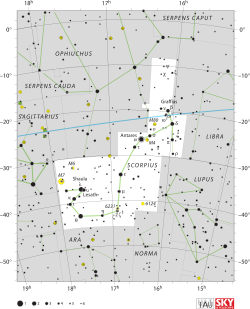Omega2 Scorpii
| Omega 2 Scorpii (ω2) | |
 | |
| Observationsdata Epok: J2000.0 | |
|---|---|
| Stjärnbild | Skorpionen |
| Rektascension | 16t 07m 24,32818s[1] |
| Deklination | -20° 52′ 07,5518″[1] |
| Skenbar magnitud () | +4,320[2] |
| Stjärntyp | |
| Spektraltyp | G6 / 8III[3] |
| U–B | +0,494[2] |
| B–V | +0,850[2] |
| Astrometri | |
| Radialhastighet () | -5,4 [4] km/s |
| Egenrörelse (µ) | RA: +44,81[1] mas/år Dek.: -45,42[1] mas/år |
| Parallax () | 11,22 ± 0,32[1] mas |
| Avstånd | 291 ± 8 lå (89 ± 3 pc) |
| Absolut magnitud () | -0,62[5] |
| Detaljer | |
| Massa | 3,27[5] M☉ |
| Radie | 15,6 [6] R☉ |
| Luminositet | 141[7] L☉ |
| Temperatur | 5,363 ± 42[8] K |
| Metallicitet | +0,03 ± 0.05[8] |
| Ålder | 282[5] miljoner år |
| Andra beteckningar | |
| 10 Scorpii, BD -20 ° 4408 , HD 144608, HIP 78990, HR 5997, SAO 184135.[9] | |
Omega 2 Scorpii (ω2 Scorpii, förkortat Omega 2 Sco, ω2 Sco), som är stjärnans Bayerbeteckning, är en, troligen variabel,[10] stjärna belägen i norra delen av stjärnbilden Skorpionen. Den har en skenbar magnitud på 4,32[2] och är synlig för blotta ögat. Baserat på parallaxmätningar[1] befinner den sig på ett avstånd av 291 ljusår (ca 89 parsek) från solen. Dess skenbara magnitud reduceras med 0,38 på grund av skymning från interstellärt stoft.[5] Stjärnan är ena komponenten i den visuella dubbelstjärnan ω Scorpii.
Egenskaper
[redigera | redigera wikitext]Omega 2 Scorpii är en jättestjärna av typ G med spektralklass G6/8III.[3] Med en beräknad ålder på 282 miljoner år,[5] är den en utvecklad, tunn diskformad stjärna som för närvarande befinner sig på den röda horisontella grenen i HR-diagrammet.[11] Vinkeldiametern hos stjärnan är enligt interferometrimätningar 1,63 ± 0,10 mas,[12] som vid dess uppskattade avstånd motsvarar en fysisk radie på nästan 16 gånger solens radie.[6] Den har en massa som är 3,27 gånger solens massa[5] och dess utstrålarnning av energi är 141 gånger större än solens ljusstyrka.[7] Dess yttre atmosfär har en effektiv temperatur på 5 363 K.[8]
Källor
[redigera | redigera wikitext]- Den här artikeln är helt eller delvis baserad på material från engelskspråkiga Wikipedia, tidigare version.
Referenser
[redigera | redigera wikitext]- ^ [a b c d e f] van Leeuwen, F. (2007), "Validation of the new Hipparcos reduction", Astronomy and Astrophysics, 474 (2): 653–664, Bibcode:2007A&A...474..653V, arXiv:0708.1752 Freely accessible, doi:10.1051/0004-6361:20078357.
- ^ [a b c d] Kozok, J. R. (September 1985), "Photometric observations of emission B-stars in the southern Milky Way", Astronomy and Astrophysics Supplement Series, 61: 387–405, Bibcode:1985A&AS...61..387K.
- ^ [a b] Houk, N.; Smith-Moore, M. (1988), Michigan Catalogue of Two-dimensional Spectral Types for the HD Stars. Declinations -26°.0 to -12°.0, 4, Bibcode:1988MSS...C04....0H.
- ^ Wilson, R. E. (1953), General Catalogue of Stellar Radial Velocities, Carnegie Institute of Washington D.C., Bibcode:1953GCRV..C......0W.
- ^ [a b c d e f] Takeda, Yoichi; et al. (August 2008), "Stellar Parameters and Elemental Abundances of Late-G Giants", Publications of the Astronomical Society of Japan, 60 (4): 781–802, Bibcode:2008PASJ...60..781T, arXiv:0805.2434 Freely accessible, doi:10.1093/pasj/60.4.781.
- ^ [a b] Lang, Kenneth R. (2006), Astrophysical formulae, Astronomy and astrophysics library, 1 (3 ed.), Birkhäuser, ISBN 3-540-29692-1.. The radius (R*) is given by::
- ^ [a b] McDonald, I.; et al. (2012), "Fundamental Parameters and Infrared Excesses of Hipparcos Stars", Monthly Notices of the Royal Astronomical Society, 427 (1): 343–57, Bibcode:2012MNRAS.427..343M, arXiv:1208.2037 Freely accessible, doi:10.1111/j.1365-2966.2012.21873.x.
- ^ [a b c] Prugniel, P.; et al. (2011), "The atmospheric parameters and spectral interpolator for the MILES stars", Astronomy & Astrophysics, 531: A165, Bibcode:2011A&A...531A.165P, arXiv:1104.4952 Freely accessible, doi:10.1051/0004-6361/201116769.
- ^ "* ome02 Sco". SIMBAD. Centre de données astronomiques de Strasbourg. Hämtad 2016-09-25.
- ^ Sterken, C. (January 1977), "uvby Photometry of the Suspected Variable omega2 Sco", Information Bulletin on Variable Stars, 1230: 1, Bibcode:1977IBVS.1230....1S.
- ^ Afşar, M.; et al. (July 2012), "Chemical Compositions of Thin-disk, High-metallicity Red Horizontal-branch Field Stars", The Astronomical Journal, 144 (1): 20, Bibcode:2012AJ....144...20A, arXiv:1205.3659 Freely accessible, doi:10.1088/0004-6256/144/1/20, 20.
- ^ Richichi, A.; Percheron, I. (May 2002), "CHARM: A Catalog of High Angular Resolution Measurements", Astronomy and Astrophysics, 386: 492–503, Bibcode:2002A&A...386..492R, doi:10.1051/0004-6361:20020236.
Externa länkar
[redigera | redigera wikitext]Text is available under the CC BY-SA 4.0 license; additional terms may apply.
Images, videos and audio are available under their respective licenses.






